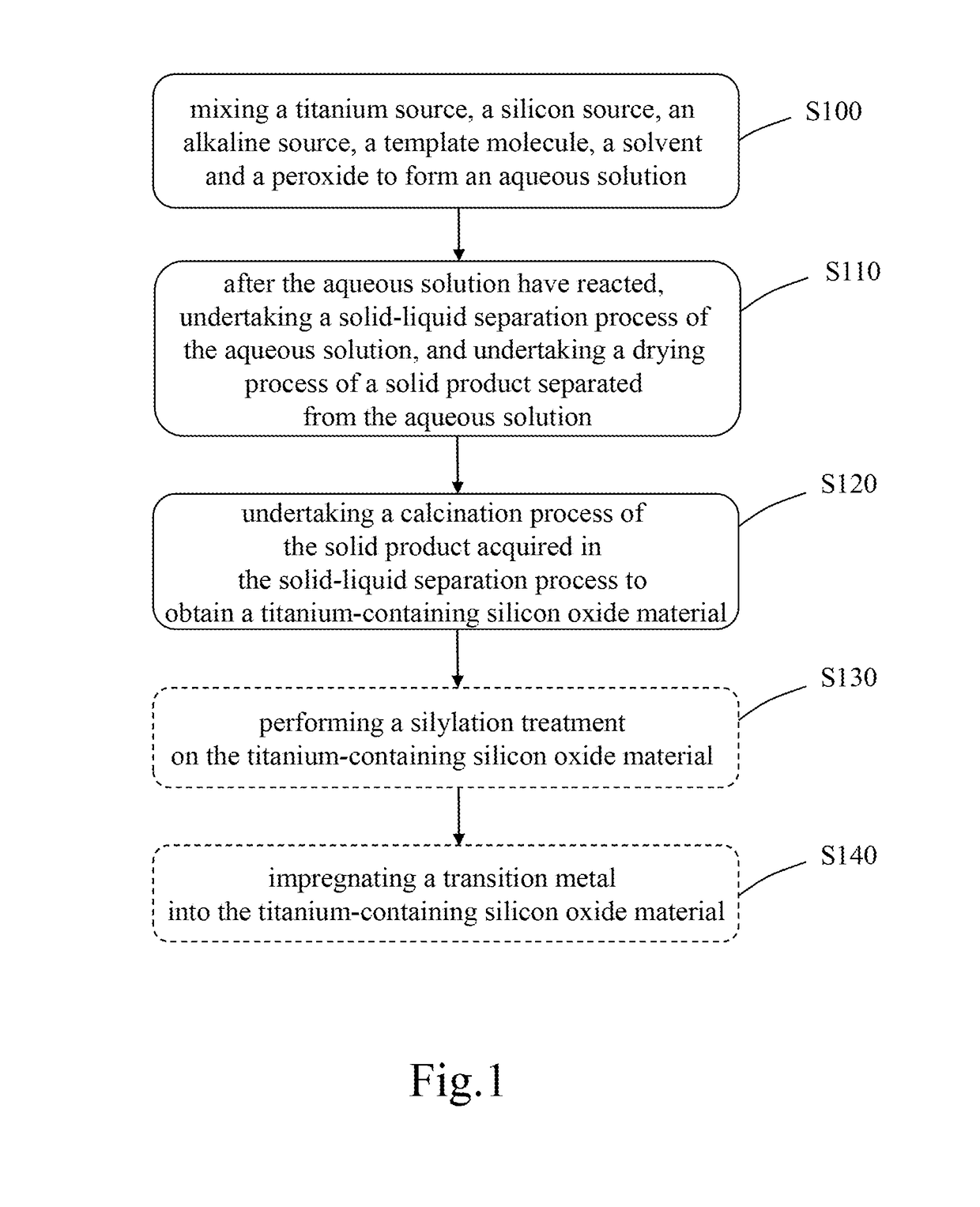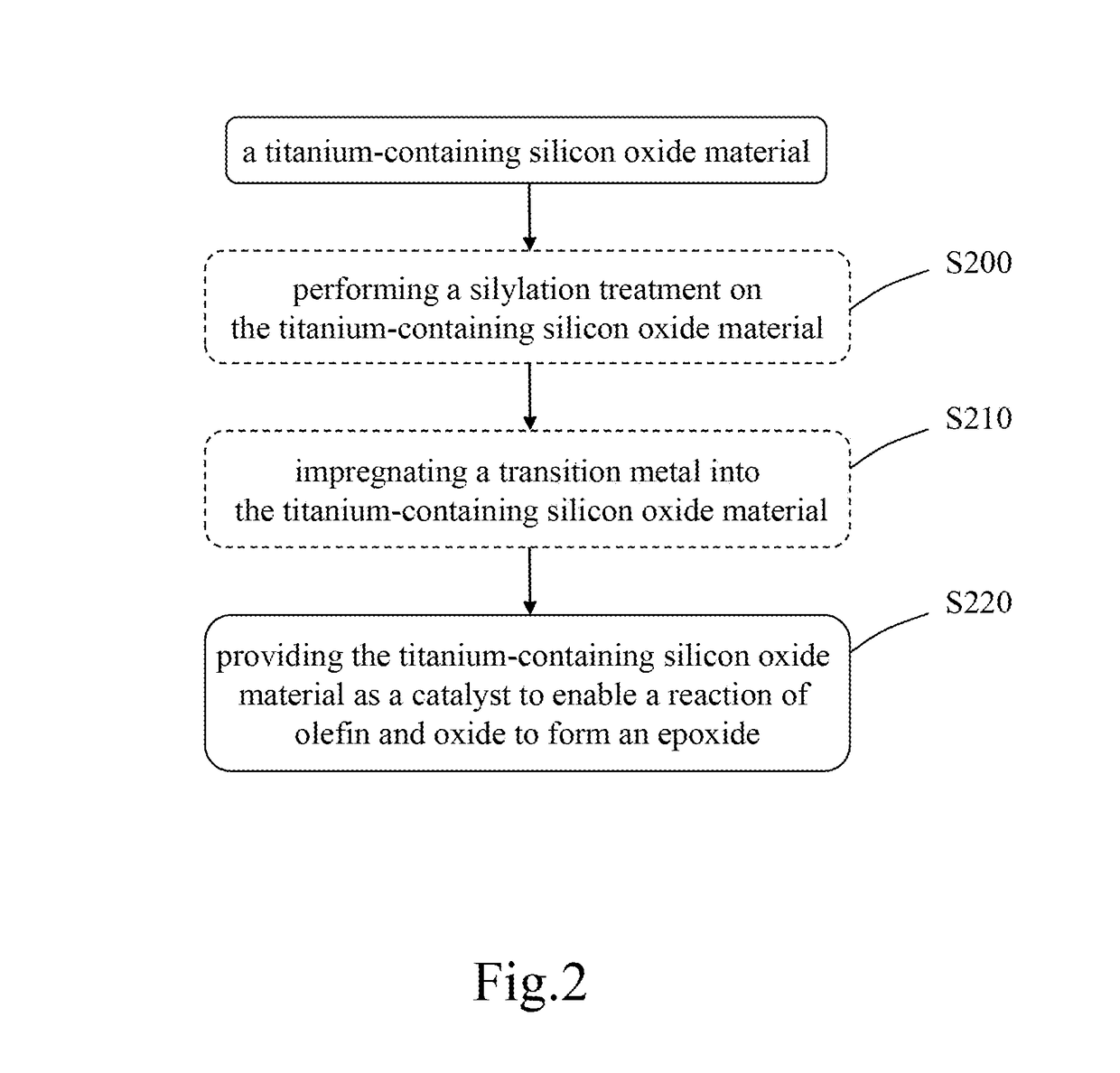Method for fabricating a titanium-containing silicon oxide material with high thermal stability and applications of the same
a technology of titanium-containing silicon oxide and high thermal stability, which is applied in the direction of silicon compounds, catalyst activation/preparation, physical/chemical process catalysts, etc., can solve the problem of high temperature sensitive titanium, and achieve high thermal stability, high specific surface area, and high thermal stability
- Summary
- Abstract
- Description
- Claims
- Application Information
AI Technical Summary
Benefits of technology
Problems solved by technology
Method used
Image
Examples
embodiment i
Fabrication of a Titanium-Containing Silicon Oxide Material:
[0060]Use 0.58 kg of tetraisopropylorthotitanate, 15.6 kg of tetraethylorthosilicate, 4.56 kg of 28 wt % ammonia aqueous solution, 7.81 kg of cetyltrimethylammonium hydroxide, 2.42 kg of 35 wt % hydrogen peroxide aqueous solution, 3 kg of isopropyl alcohol, and 24.6 kg of water to prepare a reaction liquid. Agitate the reaction liquid at an ambient temperature for 3 hours. Filter the reaction liquid to remove the solution and obtain a powder. Dry the powder at a temperature of 70° C. Heat the dried powder at a temperature rising speed of 5° C. / min to a temperature of 550° C., and calcine the dried powder at the temperature of 550° C. for 6 hours. Then, let the powder cool down naturally.
Fabrication of Propylene Epoxide:
[0061]Use 7.5 g of titanium-containing silicon oxide material fabricated in Embodiment I as the catalyst. Uniformly mix the catalytic material, 225 g of 25 wt % cumene hydroperoxide solution (cumene is the so...
embodiment ii
Fabrication of a Titanium-Containing Silicon Oxide Material:
[0062]The process for fabricating a titanium-containing silicon oxide material is the same as Embodiment I except Embodiment II further takes 16.5 g of the titanium-containing silicon oxide material to undertake silylation. Mix the titanium-containing silicon oxide material with 165 g of toluene and 11.2 g of hexamethyldisilazane uniformly to form a solution. Next, agitate the solution at a temperature of 120° C. for 1 hour to obtain a suspension. Next, filter the suspension to obtain a powder as the catalytic material.
Fabrication of Propylene Epoxide:
[0063]The process for fabricating propylene epoxide is the same as Embodiment I except the titanium-containing silicon oxide material fabricated in Embodiment II is used as the catalyst. The result of the reaction is shown in Table. 1.
embodiment iii
Fabrication of a Titanium-Containing Silicon Oxide Material:
[0064]The process for fabricating a titanium-containing silicon oxide material is the same as Embodiment II except Embodiment III further uses a compression molding method to granulate the titanium-containing silicon oxide material having a particle diameter of 1-2 mm.
Fabrication of Propylene Epoxide:
[0065]The process for fabricating propylene epoxide is the same as Embodiment I except the titanium-containing silicon oxide material fabricated in Embodiment III is used as the catalyst. The result of the reaction is shown in Table.1.
PUM
| Property | Measurement | Unit |
|---|---|---|
| Temperature | aaaaa | aaaaa |
| Temperature | aaaaa | aaaaa |
| Temperature | aaaaa | aaaaa |
Abstract
Description
Claims
Application Information
 Login to View More
Login to View More - R&D
- Intellectual Property
- Life Sciences
- Materials
- Tech Scout
- Unparalleled Data Quality
- Higher Quality Content
- 60% Fewer Hallucinations
Browse by: Latest US Patents, China's latest patents, Technical Efficacy Thesaurus, Application Domain, Technology Topic, Popular Technical Reports.
© 2025 PatSnap. All rights reserved.Legal|Privacy policy|Modern Slavery Act Transparency Statement|Sitemap|About US| Contact US: help@patsnap.com


